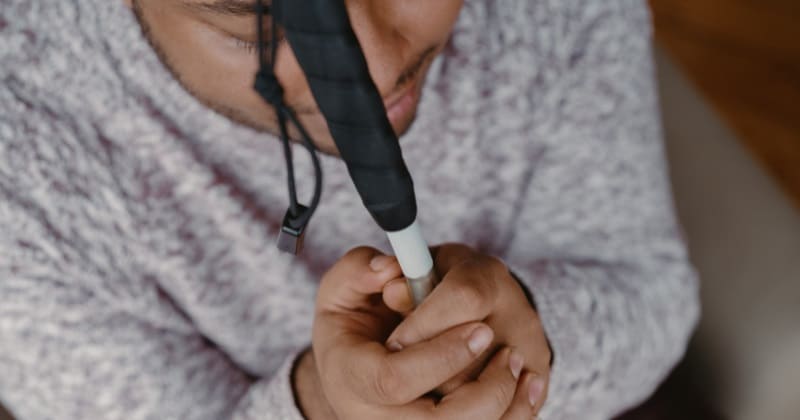Veterans often develop glaucoma due to exposure to harmful environments, eye trauma, diabetes, high blood pressure, and other factors that increase intraocular pressure, leading to progressive vision loss. However, proving that glaucoma is linked to military service can be challenging. We help veterans understand the VA rating system and how to establish a service connection for glaucoma to obtain disability benefits.
How the VA Rates Glaucoma
To determine the severity of a veteran’s glaucoma, the VA may require a Compensation & Pension (C&P) exam conducted by an eye specialist. This examination assesses key factors such as central visual acuity, peripheral vision loss, and eye muscle function impairment to evaluate how much the condition has affected daily life and employment capabilities.
The VA rates glaucoma under 38 CFR §4.79, Schedule of Ratings for the Eye. The rating criteria are:
- Loss of visual acuity: clarity or sharpness of vision
- Loss of visual field: extent of peripheral vision
- Frequency of incapacitating episodes: periods requiring medical intervention
Glaucoma can lead to a progressive loss of vision, including:
- Blurry vision
- Tunnel vision
- Blind spots
- Complete blindness in severe cases
The VA assigns disability ratings based on measurement charts that assess central and peripheral vision impairment.
Types of Glaucoma Recognized by the VA
The VA categorizes glaucoma into two main types: Angle-Closure and Open-Angle. Angle-Closure Glaucoma develops rapidly and can cause sudden increases in eye pressure, leading to severe vision impairment if not treated promptly. In contrast, Open-Angle Glaucoma progresses gradually, slowly reducing peripheral vision and, over time, leading to significant visual impairment.
Open-Angle Glaucoma
- The most common type
- Develops slowly over time
- Can lead to irreversible vision loss
Angle-Closure Glaucoma
- Less common but more severe
- Can cause sudden blindness
- Requires immediate medical attention
What is the VA Rating for Glaucoma?
VA disability ratings for glaucoma range from 10% to 60%, according to the § 4.79 Schedule of ratings of the eye. The VA evaluates the extent of vision loss, field of vision restriction, and whether the condition leads to incapacitating episodes.
- 10% rating: With documented incapacitating episodes requiring at least 1 but less than 3 treatment visits for an eye condition during the past 12 months
- 20% rating: With documented incapacitating episodes requiring at least 3 but less than 5 treatment visits for an eye condition during the past 12 months
- 40% rating: With documented incapacitating episodes requiring at least 5 but less than 7 treatment visits for an eye condition during the past 12 months
- 60% rating: With documented incapacitating episodes requiring 7 or more treatment visits for an eye condition during the past 12 months
- Higher ratings (up to 100%) may apply if glaucoma leads to total blindness
How to Service Connect Glaucoma
To establish service connection for glaucoma, veterans must provide:
- Medical records showing a diagnosis
- Service treatment records linking glaucoma to military service
- Nexus letter from a medical professional confirming service connection
- VA C&P exam results (if required)
Additionally, veterans can submit lay evidence to support their claim. Lay evidence includes written statements from the veteran, family members, friends, coworkers, or fellow service members who can attest to the impact of glaucoma on daily life.
These personal accounts can provide valuable insight into how the condition developed and progressed over time, offering supplemental proof to strengthen the case for service connection.
Secondary Service Connection
Establishing a direct service connection may be difficult, as glaucoma can also have genetic causes. However, veterans are eligible for benefits if they prove that their glaucoma was triggered or aggravated by a service-related condition. This is known as secondary service connection and can be an effective way to secure VA disability benefits.
Several conditions have been linked to the onset or worsening of glaucoma:
- Severe eye trauma or injury: Damage sustained during service can lead to traumatic glaucoma, which results from increased intraocular pressure.
- Diabetes mellitus: This condition can lead to abnormal blood vessel growth in the retina, which may obstruct eye drainage and cause glaucoma.
- Hypertension (high blood pressure): Elevated pressure can weaken and damage the small blood vessels in the eyes, contributing to glaucoma development.
- Traumatic brain injury (TBI): TBI causes damage to optic nerves
- PTSD medications: Some medications can increase eye pressure
To establish glaucoma as a secondary disability, veterans must first prove a service connection for the primary condition that caused or exacerbated their glaucoma.
This requires medical evidence showing that the primary condition is linked to military service and that it directly led to or worsened. If the veteran was exposed to toxins such as Agent Orange, conditions like diabetes or hypertension may be presumptive.
The VA Process: What to Expect
The C&P Exam for Glaucoma
Once a claim for glaucoma has been filed, the VA may request a Compensation and Pension (C&P) exam to assess the severity of the condition. Typically, this exam is conducted by a VA physician or a VA-contracted physician, and since glaucoma affects the eyes, it may be performed by an optometrist.
The examiner will physically evaluate the veteran’s eyes and may also ask questions about military service, symptom progression, and daily limitations caused by glaucoma.
VA will notify veterans about their scheduled C&P exam via phone or mail, making it crucial for veterans to keep their contact information updated with the VA. Failure to attend the exam without rescheduling may result in a denied claim.
Before the exam, the examiner will review the veteran’s C-file, which contains previously submitted documentation, military service records, and medical history. Veterans may also submit a Disability Benefits Questionnaire (DBQ) to strengthen their claim. A DBQ allows veterans to provide details about their symptoms, severity, and possible service-related causes, and it can also be completed by a private optometrist, offering an additional professional opinion that may support the claim.
If the VA requires a Compensation & Pension (C&P) exam, veterans should be prepared to:
- Undergo a visual acuity and field test
- Provide service medical history
- Discuss how glaucoma affects daily life
- Explain occupational limitations
Denied by the VA? You Still Have Options
The VA frequently denies glaucoma claims due to lack of service connection proof. If denied, veterans can:
- File for a Higher-Level Review
- Submit a Supplemental Claim with new evidence
- Appeal the decision at the Board of Veterans Appeals
How to Increase a Glaucoma Rating
Glaucoma worsens over time, leading to increased vision loss. Veterans can request a rating increase if:
- Vision deteriorates significantly (e.g., unable to drive, difficulty reading)
- Peripheral vision loss expands
- New medical evidence supports worsening symptoms
A VA re-exam may be required to assess the progression.
TDIU for Glaucoma
Veterans with severe glaucoma may qualify for Total Disability Individual Unemployability (TDIU) if their condition prevents them from working. This applies if:
- Glaucoma is rated at least 60%
- The combined VA rating reaches 70% (with one disability at 40%)
- The veteran is unable to maintain substantial employment
Example: a veteran with glaucoma (60%) and diabetes (20%) may qualify for TDIU if they prove that vision loss prevents them from working.
If you’re a disabled veteran seeking benefits for glaucoma and the VA either denied your claim or awarded a lower percent rating than you should have, Hill & Ponton is here to help. Our team can assess your disability claim and entitlement to VA benefits. Contact us today for a free case evaluation.




